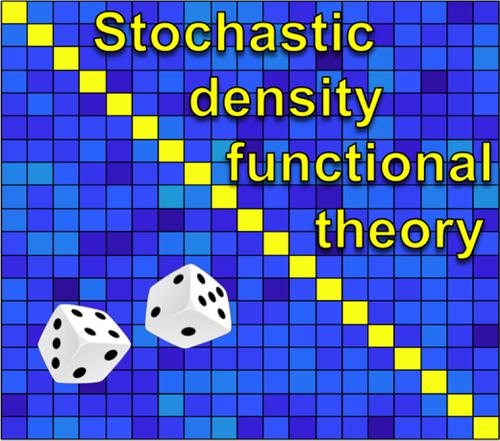当前位置:
X-MOL 学术
›
WIREs Comput. Mol. Sci.
›
论文详情
Our official English website, www.x-mol.net, welcomes your
feedback! (Note: you will need to create a separate account there.)
Stochastic density functional theory
Wiley Interdisciplinary Reviews: Computational Molecular Science ( IF 16.8 ) Pub Date : 2019-04-17 , DOI: 10.1002/wcms.1412 Marcel D. Fabian 1 , Ben Shpiro 1 , Eran Rabani 2, 3, 4 , Daniel Neuhauser 5 , Roi Baer 1
Wiley Interdisciplinary Reviews: Computational Molecular Science ( IF 16.8 ) Pub Date : 2019-04-17 , DOI: 10.1002/wcms.1412 Marcel D. Fabian 1 , Ben Shpiro 1 , Eran Rabani 2, 3, 4 , Daniel Neuhauser 5 , Roi Baer 1
Affiliation

|
Linear‐scaling implementations of density functional theory (DFT) reach their intended efficiency regime only when applied to systems having a physical size larger than the range of their Kohn–Sham density matrix (DM). This causes a problem since many types of large systems of interest have a rather broad DM range and are therefore not amenable to analysis using DFT methods. For this reason, the recently proposed stochastic DFT (sDFT), avoiding exhaustive DM evaluations, is emerging as an attractive alternative linear‐scaling approach. This review develops a general formulation of sDFT in terms of a (non)orthogonal basis representation and offers an analysis of the statistical errors (SEs) involved in the calculation. Using a new Gaussian‐type basis‐set implementation of sDFT, applied to water clusters and silicon nanocrystals, it demonstrates and explains how the standard deviation and the bias depend on the sampling rate and the system size in various types of calculations. We also develop a basis‐set embedded‐fragments theory, demonstrating its utility for reducing the SEs for energy, density of states and nuclear force calculations. Finally, we discuss the algorithmic complexity of sDFT, showing it has CPU wall‐time linear‐scaling. The method parallelizes well over distributed processors with good scalability and therefore may find use in the upcoming exascale computing architectures.
中文翻译:

随机密度泛函理论
密度泛函理论(DFT)的线性缩放实现仅在应用于物理尺寸大于其Kohn-Sham密度矩阵(DM)范围的系统时才达到其预期的效率范围。这引起了一个问题,因为许多类型的大型关注系统都具有相当宽的DM范围,因此不适合使用DFT方法进行分析。因此,最近提出的随机DFT(sDFT)避免了详尽的DM评估,正在成为一种有吸引力的线性缩放方法。这篇综述根据(非)正交基础表示法开发了sDFT的一般表述,并提供了对计算中涉及的统计误差(SE)的分析。使用适用于水团簇和硅纳米晶体的sDFT的新高斯型基集实现,它演示并解释了在各种类型的计算中标准偏差和偏差如何取决于采样率和系统大小。我们还开发了一种基础设置的嵌入式碎片理论,展示了其在减少能源,状态密度和核力计算的SE方面的效用。最后,我们讨论了sDFT的算法复杂性,表明它具有CPU墙时间线性缩放。该方法在具有良好可扩展性的分布式处理器上很好地并行化,因此可以在即将到来的亿亿次计算体系结构中找到用途。状态密度和核力计算。最后,我们讨论了sDFT的算法复杂性,表明它具有CPU墙时间线性缩放。该方法在具有良好可扩展性的分布式处理器上很好地并行化,因此可以在即将到来的百亿亿次计算体系结构中找到用途。状态密度和核力计算。最后,我们讨论了sDFT的算法复杂性,表明它具有CPU墙时间线性缩放。该方法在具有良好可扩展性的分布式处理器上很好地并行化,因此可以在即将到来的百亿亿次计算体系结构中找到用途。
更新日期:2019-05-16
中文翻译:

随机密度泛函理论
密度泛函理论(DFT)的线性缩放实现仅在应用于物理尺寸大于其Kohn-Sham密度矩阵(DM)范围的系统时才达到其预期的效率范围。这引起了一个问题,因为许多类型的大型关注系统都具有相当宽的DM范围,因此不适合使用DFT方法进行分析。因此,最近提出的随机DFT(sDFT)避免了详尽的DM评估,正在成为一种有吸引力的线性缩放方法。这篇综述根据(非)正交基础表示法开发了sDFT的一般表述,并提供了对计算中涉及的统计误差(SE)的分析。使用适用于水团簇和硅纳米晶体的sDFT的新高斯型基集实现,它演示并解释了在各种类型的计算中标准偏差和偏差如何取决于采样率和系统大小。我们还开发了一种基础设置的嵌入式碎片理论,展示了其在减少能源,状态密度和核力计算的SE方面的效用。最后,我们讨论了sDFT的算法复杂性,表明它具有CPU墙时间线性缩放。该方法在具有良好可扩展性的分布式处理器上很好地并行化,因此可以在即将到来的亿亿次计算体系结构中找到用途。状态密度和核力计算。最后,我们讨论了sDFT的算法复杂性,表明它具有CPU墙时间线性缩放。该方法在具有良好可扩展性的分布式处理器上很好地并行化,因此可以在即将到来的百亿亿次计算体系结构中找到用途。状态密度和核力计算。最后,我们讨论了sDFT的算法复杂性,表明它具有CPU墙时间线性缩放。该方法在具有良好可扩展性的分布式处理器上很好地并行化,因此可以在即将到来的百亿亿次计算体系结构中找到用途。











































 京公网安备 11010802027423号
京公网安备 11010802027423号